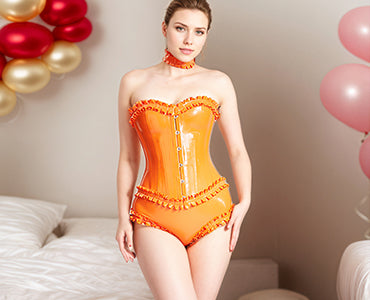The Beginner's Guide to Wearing Latex Clothing
Stepping into the world of latex fashion can feel both exciting and intimidating. Whether you're drawn to its sleek aesthetic or empowering feel, this guide will walk you through everything you need to know to wear latex with confidence and comfort.
Understanding Latex Fashion
Latex clothing is made from natural rubber derived from the sap of rubber trees. This material is processed and sheeted into thin layers that can be cut and glued together to create garments. Unlike traditional fabrics that are woven or knitted, latex is a continuous sheet material, which gives it that signature second-skin feel.
The difference you'll notice immediately is how latex interacts with your body. Where cotton breathes and silk flows, latex hugs every contour. It doesn't absorb moisture like regular fabrics, so you'll feel warmer and may perspire more. This unique characteristic is part of what makes latex so distinctive, but it also means you'll need to adjust your expectations about comfort and wearability.
Common latex garments include dresses, leggings, bodysuits, skirts, gloves, stockings, and even full catsuits. Each piece offers a different entry point into latex fashion, with simpler items like gloves or a basic skirt being ideal for beginners.
The thickness of latex, measured in millimeters, significantly affects both appearance and comfort. Thinner latex (around 0.25mm to 0.35mm) is easier to move in and feels less restrictive, making it appealing for beginners. However, keep in mind that thinner latex is also more delicate and prone to tearing, so it requires extra care during dressing and wearing. Thicker latex (0.45mm and above) offers more structure, durability, and tear resistance but can be more restrictive and challenging to put on. Many beginners find medium thickness (around 0.40mm) offers the best balance of durability and wearability. The shine level, which can range from matte to high polish, is typically achieved through the application of shine products after dressing and affects the overall aesthetic impact of your outfit.

Why Latex Has Become a Fashion Trend
Latex has moved from underground subcultures into mainstream fashion consciousness, thanks largely to bold celebrities and performers. Lady Gaga's iconic latex looks, Bella Hadid's sleek latex dresses on red carpets, and Kim Kardashian's figure-hugging latex ensembles have brought this material into the spotlight. When high-profile fashion moments feature latex, it signals that this material has earned its place in contemporary style.
The aesthetic appeal of latex is undeniable. The high-shine finish catches light in a way no other material can, creating an almost liquid appearance. The way latex fits the body celebrates curves and creates a silhouette that's simultaneously futuristic and timeless. There's an inherent boldness to wearing latex that makes a powerful statement.
Beyond aesthetics, latex has become a symbol of confidence and individuality. Wearing latex requires a certain level of self-assurance. It's not a material you can hide in. This visibility becomes empowering for many wearers who find that latex helps them embrace their bodies and express themselves authentically. It's fashion as armor, fashion as art, and fashion as personal declaration all at once.
Getting Started
Choosing Your First Latex Outfit
Your first latex piece should be something manageable that won't overwhelm you. I always recommend starting with items that are easier to put on and remove. A latex skirt, pair of leggings, or a simple top are excellent entry points. These pieces let you experience the material without the commitment and complexity of a full catsuit or intricate dress.
Save the elaborate pieces for when you've developed some comfort with the material. A catsuit might look amazing, but struggling with it for your first experience could sour your relationship with latex before it even begins.
Sizing is critical with latex. Unlike stretchy fabrics that accommodate a range of sizes, latex needs to fit snugly without being restrictive. Too loose and it will wrinkle and lose its sleek appearance. Too tight and you'll be uncomfortable and risk tearing the material. Most reputable latex designers provide detailed measurement guides. Take your measurements carefully, following their instructions exactly, and don't rely on your standard clothing size.
When deciding between custom and ready-to-wear options, consider your budget and body type. Ready-to-wear pieces are more affordable and immediately available, making them perfect for testing whether latex is right for you. Custom pieces ensure a perfect fit and allow for personalization, but they require a larger investment and waiting time. For your first piece, ready-to-wear often makes the most sense, but if you have specific fit concerns or have struggled with standard sizing in other clothing, custom might be worth the investment from the start.
How to Put On Latex Clothing (Without Stress)
Latex is clingy by nature, which makes it challenging to put on. Your skin naturally creates friction against the rubber, causing it to grab and resist sliding. This is why dressing aids are essential, not optional.
Here's your step-by-step guide to dressing in latex:
Start by applying a silicone-based lubricant or specialized latex dressing aid to the inside of the garment. Some people also apply a light layer to their skin. The lubricant creates a slippery barrier that allows the latex to glide over your body. Never use oil-based products, as these will degrade the latex.
Remove all jewelry, especially rings and bracelets, and make sure your nails are smooth without sharp edges. Even a tiny snag can create a tear in latex. If you have long nails, consider wearing thin cotton gloves during the dressing process.
Take your time. Rushing is the enemy of latex dressing. Gather the latex and roll it onto your body rather than pulling it. If you're putting on pants or leggings, scrunch the leg up like you would with pantyhose, insert your foot, then gradually roll the material up your leg. For tops and dresses, step into them when possible rather than pulling them over your head.
If you feel stuck, stop and add more lubricant rather than forcing the material. Forcing latex almost always results in tears.
What to Do If Latex Tears: Small tears can often be repaired with latex glue or patches designed specifically for this purpose. Clean the area around the tear, apply the adhesive according to the product instructions, and allow it to cure fully before wearing the garment again. For significant tears or tears in visible areas, professional repair services can sometimes restore the piece, though prevention through careful handling is always the best approach.
More reading: Wearing Latex Clothing Step by Step
Styling Tips for Latex Beginners
One of the biggest misconceptions about latex is that you have to commit to a full latex look. In reality, mixing latex with everyday pieces creates approachable, wearable outfits that feel less costume-like and more contemporary fashion.
Try pairing a latex pencil skirt with a simple cotton t-shirt and sneakers for a casual daytime look. The contrast between materials creates visual interest without overwhelming your outfit. A latex top can be styled with jeans and a blazer for an edgy take on business casual. The key is balance. Let the latex be your statement piece and keep everything else relatively simple.
Color coordination opens up endless possibilities. Black latex is classic and versatile, pairing well with virtually anything. Red latex makes a bold statement and works beautifully with black, white, or neutral tones. Colored latex in jewel tones like emerald or sapphire can be treated like any other colored garment in your wardrobe, following standard color theory principles.
Texture pairing adds depth to your outfits. The slick, reflective surface of latex creates beautiful contrast with matte fabrics like cotton, wool, or suede. Mixing textures prevents your outfit from feeling one-dimensional.
For daytime wear, keep it subtle. A latex accessory like gloves or a belt, or a single latex garment paired with casual pieces, feels appropriate and stylish. Evening looks can be more dramatic. This is when you can embrace fuller latex ensembles, brighter colors, or more elaborate designs.
Accessorizing latex requires some thought. Shoes should complement without competing; sleek heels or boots work beautifully with latex's polished aesthetic, while chunky sneakers can create an interesting high-low mix. Bags in leather or structured materials balance the fluidity of latex. For outerwear, consider how textures work together. A leather jacket over latex creates a cohesive edgy look, while a structured coat provides elegant contrast.
Safety and Skin Care Tips
Latex allergies affect a significant portion of the population and can be serious. If you've never worn latex before, you should do a patch test, especially if you have sensitive skin or known allergies to other materials. Apply a small piece of latex to your inner arm for several hours and watch for redness, itching, or irritation. If you experience any allergic reaction, discontinue use immediately and consult a healthcare provider.
Skin preparation makes a significant difference in your wearing experience. For best results, moisturize your body the night before or several hours before wearing latex, allowing the moisturizer to fully absorb into your skin. Your skin should feel smooth and hydrated but completely dry to the touch when you're ready to dress. Applying moisturizer right before putting on latex will create a greasy barrier that interferes with dressing and can trap moisture against your skin. Well-hydrated skin is healthier and more comfortable under latex. Some people find that shaving or trimming body hair makes latex more comfortable, as hair can pull or create friction under the tight material.
If you experience irritation while wearing latex, it might not be an allergy. Sometimes irritation comes from friction, heat buildup, or trapped moisture. If you feel uncomfortable, remove the garment and give your skin a break. Make sure you're not wearing latex for extended periods when you're first starting out. Build up your tolerance gradually.
Explore more: How to Care for Latex Clothes? Cleaning, Polishing, and Storage
Common Mistakes Beginners Make
Choosing garments that are too tight is probably the most common beginner mistake. The desire to achieve that ultra-sleek look can tempt you toward smaller sizes, but overly tight latex is not only uncomfortable but also more likely to tear. Remember that properly fitted latex should already hug your body closely. Going smaller won't improve the look and will definitely compromise your comfort.
Using oil-based products around latex will destroy it. This includes many lotions, body oils, perfumes, and even some sunscreens. Always check product ingredients and when in doubt, wait for topical products to fully absorb before putting on latex, or avoid applying them to areas that will be covered by the garment.
Storage might not seem important until you pull out a latex piece that's stuck to itself or has changed color. Latex should be stored clean, dry, and lightly dusted with unscented talcum powder or specialized latex powder to prevent the material from sticking to itself. Keep pieces in a cool, dark place away from direct sunlight, which can cause discoloration. Don't fold latex tightly or store it under heavy items. Hanging on padded hangers or laying flat are the best storage methods.
Neglecting aftercare is the fastest way to shorten your latex wardrobe's lifespan. After each wearing, wash your latex with mild soap and water, dry it thoroughly, and apply powder before storing. This routine only takes a few minutes but makes an enormous difference in how long your pieces last and how good they look.
Recommended Latex Brands for Beginners
Finding quality latex from reputable brands ensures you're getting garments that fit well, feel good, and last. Atsuko Kudo offers beautifully crafted pieces with feminine silhouettes that are perfect for those wanting elegant latex fashion. William Wilde creates more avant-garde designs that push boundaries while maintaining wearability.
For those seeking accessible entry points into latex fashion, LatexBuy provides a range of options suitable for beginners exploring the material for the first time.
When shopping for latex, look for brands that provide detailed size guides, transparent information about latex thickness and quality, and clear care instructions. Good customer service and return policies are also important, especially when you're still figuring out what works for your body and style.

FAQs
Is latex comfortable to wear?
Comfort in latex is different from comfort in regular clothing, but yes, it can be comfortable once you adjust to the sensation. Properly fitted latex that's been correctly put on with adequate lubricant shouldn't feel painful or overly restrictive. However, you will feel warm, and the material doesn't breathe like cotton or other natural fibers. Many people find latex comfortable for several hours, but it's not typically an all-day material. Your comfort level will improve as you become more experienced with the material.
Can I wear latex in warm weather?
Technically yes, but it's challenging. Latex traps heat and doesn't allow your skin to breathe, so you'll feel significantly warmer than you would in regular clothing. If you do wear latex in warm weather, stay in air-conditioned spaces when possible, stay hydrated, and consider thinner latex pieces or items that cover less of your body. Many latex enthusiasts prefer to wear the material in cooler months or in climate-controlled environments.
How long does latex clothing last?
With proper care, latex garments can last for years. The lifespan depends on how frequently you wear them, how carefully you handle them, and how well you maintain them. Regular cleaning, proper storage, and gentle handling are the keys to longevity. Some people have latex pieces that are a decade old and still in excellent condition, while others might damage a garment quickly through neglect or rough treatment. Think of latex as an investment piece that rewards careful attention.
Can latex be repaired if damaged?
Yes, in most cases. Small tears, holes, or seam separations can often be repaired with latex glue or patches. For successful repairs, you'll need to properly prepare the surface by cleaning the area with isopropyl alcohol and allowing it to dry completely before applying the adhesive. Many latex retailers sell repair kits with detailed instructions, and some brands offer professional repair services. The repairs are often quite durable if done correctly. However, extensive damage or damage in highly visible areas might not repair invisibly. Prevention through careful handling is always better than repair, but knowing that small accidents don't mean the end of a garment can give you more confidence in wearing your latex pieces.
Conclusion
Entering the world of latex fashion is a journey of self-expression and confidence. With the right knowledge, preparation, and care, you'll discover that latex is not just wearable but genuinely enjoyable. Start small, take your time, and most importantly, have fun exploring this unique material.












